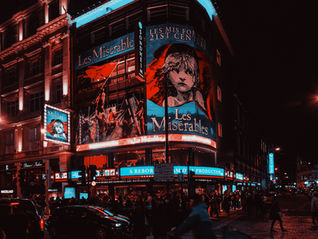Ugly Truths Our History Books Don’t Teach Us
- Tom Faletti

- May 3
- 7 min read
Updated: May 4
The treatment of Black people in American history – from slavery to Jim Crow and beyond – is much uglier than most people know.

This is the hardest article I have ever had to write.
The treatment of African Americans in U.S. history is much uglier than our textbooks tell us. This is my second conclusion from visiting Civil Rights memorials and museums in Alabama, Mississippi, and Louisiana. (I invite you to read the article explaining my first conclusion, which is: we can’t truly know American history if we don't know African American history.)
Our textbooks mostly downplay our ugly truths. They teach us very little about what it was like to be enslaved; what it was like to be subjugated in the Jim Crow South; what it was like to live in the North and still be treated as a second-class citizen; what it was and is like, even in our time, to be a person of color in a system that tolerates unequal treatment. They also don’t teach us about the hatred and lust for domination that drove many white people to perpetuate or tolerate an evil system.
Another part of the problem is that the language we use is so familiar that we have become inured to the suffering behind the words. The Equal Justice Initiative, led by Bryan Stevenson, uses different phrasings at its Legacy Sites to help us understand the horror behind the anodyne words used by historians. I have incorporated their truthful terminology here.
Christians should be particularly concerned about this because we stand for the truth. Christians often misused our Scriptures to justify their mistreatment of Black people. Some Christians today want to avoid the discomfort of facing the ugly truths in our past.
We cannot hide from the past any more than Adam and Eve could hide from God in the Garden. What was done must be acknowledged.
The history books gloss over the ugly stories in our history – from slavery to Jim Crow and beyond
Here are some examples of how the mistreatment of African Americans in U.S. history has been much uglier than most people recognize:
The “slave trade” was targeted kidnapping and human trafficking
Almost every story of American enslavement begins with a kidnapping of an ordinary person who was then crammed onto a slave ship – and this kidnapping was condoned by all the governments that could have prevented it.
The kidnapped people were often targeted: kidnappers sought out Africans with skills that would be particularly valuable in the enslavement markets in North America – for example, because they could do a better job than their enslavers of growing certain crops.
Each of these kidnapped humans was then trafficked to a place where their labor could be exploited for the profit of their enslavers. Many were trafficked multiple times, from plantation to plantation. As the Legacy Sites show, slavery was a massive, organized campaign of legal human trafficking.
The loss of freedom was only the start of many more abuses by enslavers
Contrary to the false image of the kindly slave master, enslavers were not “kind.” A kind person would not hold another human being in bondage and offer generous rewards to anyone who would help return them to bondage when they escaped. Nearly 10 million people endured forced slavery in the United States.
Many slave masters were vicious. Slaves were brutally whipped for the most minor offensives, and the floggings were conducted in as public a manner as possible to instill terror in other slaves. Enslaved people had to listen as their loved ones – their mothers, fathers, children, spouses, and partners – were cruelly whipped, humiliated, and broken. This brutality was a central tool used to extract profits from the forced labor of oppressed Black people.
The policies of the enslavers were thoroughly anti-family. First, countless enslavers routinely raped their female slaves and then refused to acknowledge their own children born of those rapes.
Second, the marriages of enslaved people were not recognized under the law, because enslaved people were not allowed to enter into contracts. Enslavers routinely and heinously broke up families by selling enslaved people who were married.
The human trafficking of American slavery broke up millions of families. The Legacy Museum estimates that, because of human trafficking in the United States, half of all the enslaved people in our nation were separated from a family member. They routinely endured the agony of watching their loved ones – parents, spouses, and children – ripped away from them and sent to a plantation elsewhere, never to be seen again.
When the Civil War ended, newly freed Black Americans sought desperately to find their trafficked loved ones, putting ads in newspapers and searching for years for the missing members of their families, mostly without success.
Enslaved people were stripped of the right to read, to pursue a profession, to meet with other people, to handle money. Imagine having a calling – to a profession, to marry the love of your life, to be educated – and not being allowed to do so. Enslavers would not allow Black Americans to exercise basic human rights.
After the Civil War, White supremacists used government power to continue the oppression in the Jim Crow era
White supremacists built an entire social structure around the continued subjugation of Black Americans after slavery was ended. Black people were forced to live a life of faked subservience: to step aside when a white person passed, to use honorifics when speaking to white people who did not similarly respect them, to act less intelligent and unoffended so they would not be called uppity and be targeted for violence. The judicial system rarely imprisoned white people who attacked or sexually assaulted Black people.
Government-enforced segregation and discrimination gave white people advantages in employment, housing, services, and the crucial right to vote.
When African Americans built successful businesses, jealous white competitors often destroyed them. We have only recently learned the magnitude of some of the monumental acts of destruction perpetrated against Black communities in places such as Tulsa, OK. Many stories remain virtually unknown.
When the Supreme Court ordered desegregation, cities and states sometimes closed schools, libraries, swimming pools, and other facilities rather than open them to their fellow citizens who happened to have a darker skin color.
The fight against equality was backed by a regime of lynchings designed to instill terror
Lynching and the threat of lynching loomed over every facet of life for Black Americans for 100 years after the Civil War. Lynching was a tool of racial terror, as the Equal Justice Initiative eloquently shows in its Legacy Museum and its National Memorial for Peace and Justice.
Racial terror lynchings were rarely an act of spontaneous hysteria by offended white people. They were often meticulously planned. In many cases, a lynching was announced in advance and published in the newspapers so that people would know when and where to come. The equivalents of modern food trucks and souvenir shops were set up to serve the white crowds. Photos of lynchings were sold, turned into postcards, and treated as trophies.
The Equal Justice Initiative has meticulously documented nearly 6,500 racial terror lynchings between 1865 and 1950, and more remain to be documented. Black men were lynched for sending a note to a white woman. Black people were lynched for speaking disrespectfully to or arguing with a white person, or for refusing to step off the sidewalk to allow a white person to pass. In some cases, wives and children were lynched because a husband or father could not be found. The easiest way to get rid of a Black man was to accuse him of raping a white woman. In many cases, lynchings were carried out even though evidence was presented before the lynching that demonstrated that no such assault had occurred.
Lynchings were conducted with incredible brutality. Men were strung up and hanged until they were half-dead, then let down, then strung up again. Bodies were shot through while hanging. The white lynchers often tortured their victims in disgusting ways before lynching them. Body parts were often mutilated.
Black people faced, and still face, discrimination in the North, the Midwest, and the West, not just in the South
Racial terror lynchings were not confined to the South. The Equal Justice Initiative has documented more than 300 racial terror lynchings in Northern, Midwestern, and Western states.
In countless cities and towns all over the country – not just in the South – Black Americans faced housing discrimination, employment discrimination, and violence.
In my own hometown of Antioch, CA, Black people were largely excluded from the town until after the Fair Housing Act of 1968 was passed.
Discriminatory treatment continues today. For example, in Antioch, court cases and Department of Justice investigations have established that the police department engaged in discriminatory actions and unnecessary violence against people of color in the past 5 years, including directing a police dog to bite victims who were not resisting. This is in supposedly liberal California. Discriminatory treatment continues in countless ways all over our country.
States continue to allow judicial practices that imprison Black people at rates far greater than their share of the offenses, a process described as “mass incarceration.”
Christians must acknowledge the whole truth, so that it can be redeemed
Why does this matter to Christians?
Enslavers and ordinary Christians throughout our nation’s history have used the Bible to justify their unequal treatment of Black people, using self-serving misinterpretations of Scripture to prop up their supposed superiority.
These were not aberrations or quaint “customs” of a few in an otherwise “good” society. A sinful hatred and the lust for the dominant position in society infected large percentages of the entire population and was intentionally written into the fabric of the entire social and legal system.
Jesus taught us to love all people as we love ourselves (Mark 12:31; Matt. 22:39).
Paul made it clear that in Christ there are no ethnic distinctions nor distinctions between slave and free (Gal. 3:28).
God issued a clarion call to free those who are oppressed that rings throughout the Scriptures (Is. 58:6; Jer. 22:3; etc.).
Christians understand that moral choices are not a matter of personal preference. Enslaving another is evil. Racism, hatred, and mistreatment of others based on their race is a sin. We must speak the truth: these actions and attitudes are sinful because they violate God’s commands and fall short of the moral law God has written in every human heart.
Christians, of all people, are the ones who can look at the worst of evils with the steadiest of eyes. We know that humans have a tendency toward sin. We know that God can make all things new when we face the truth and acknowledge sin for what it is. We know that Jesus, who is the Truth, has already led the way through the darkness of death to the light of life.
We are the ones who should be confronting the truth, not running away from it because it makes people uncomfortable.
It is time for Christians to take the lead in acknowledging the ugliness in our history, so that it can be redeemed in Christ.












Thank you for being a witness, Tom.